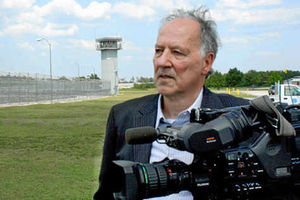Death Row - TV review
If you were asked to choose your last meal, do you know what it would be?

If you were asked to choose your last meal, do you know what it would be?
Hank Skinner does. He wanted three pieces of spicy fried chicken, two catfish fillets, eggs, bacon, salad, ranch dressing, cheese, a bacon cheeseburger, chips and chocolate milkshake.
The Texan ate it six feet from the room in which he expected to die minutes later, until his life was spared when the last moments of it seemed to be ebbing away.
Last night, filmmaker Werner Herzog brought a portrait of the condemned killer to Channel 4 in Death Row, the first of a string of interviews with inmates facing capital punishment.
On New Year's Eve in 1993, Skinner's girlfriend Twila Busby had gone to a party while he lay passed out on the settee.
They fought when she got back. She died, bludgeoned beyond recognition, and her two adult sons Randy Busby and Elwin Caler were stabbed to death.
Pampa is bleak, sparse and unloved. The storm clouds which gather above it seem appropriate when you hear the story of the doomed Busby family. Skinner still denies the act, and continues to try to prove his innocence.
Herzog lays his cards on the table from the start.
A resident of the USA, he places the concept of capital punishment in the context of his home country, Germany's, history and says he does not support the death penalty.
Skinner was within 20 minutes of execution when he ate his final dinner, and describes receiving the last rights. After being told by his lawyer he was to receive a stay, he needed to wait 21 minutes before the news became official. It sounds like a long 21 minutes.
Skinner ate his dinner around six feet away from the gurney where he expected to die. He could see it through the door as he awaited his fate.
"I was literally looking at my death while I was eating," he says.
After a beat, he adds: "I wasn't bothered by it at all."
It was only after he put the phone down to his lawyer that the tears flooded his eyes, and he slid down the wall of his cell.
"I was scared of the blackness; the unknown," he adds. "It's not something you do every day."
It's the little details that are the most affecting. There are 26 joints on a bridge which thump as the prison van drives towards the Death House. It smells of catfish. The cars behind the van transporting him are pointing at the trapped man inside.
Skinner fantasises about using a proper washing machine, and going to the supermarket. He dreams about eating avocados with limes and tequila.
It's shocking in its simplicity, and makes for powerful viewing.
The whole film is finely balanced, and whatever your view on capital punishment, you're unlikely to change your stance having seen it.
But I'm not entirely sure that's the point, rather to paint a picture of a convicted killer, and his experience of waiting for death, all the while trapped in a small concrete box, snatching glimpses of a world outside he will never inhabit again.
When all is said and done, it's one of the most affecting things I've seen on television in some time.
I certainly wouldn't say I'm looking forward to the next instalment, but I suspect I'll be watching all the same.




